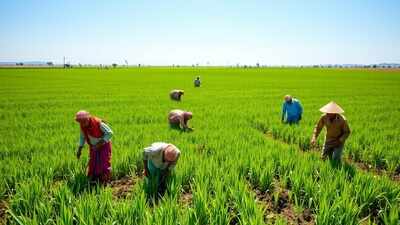Kharif sowing rises over 11%, monsoon gains pace; bodes well for food inflation: Report

Kharif sowing is off to a robust start this year, registering an 11.3 per cent year-on-year (YoY) increase as of June-end, driven by a sharp jump in rice and pulses acreage, according to a recent report by ICICI Bank. The surge in sowing is expected to support a favourable food inflation outlook for the remainder of the year.As per news agency ANI, the report highlighted that rice sowing is up by an impressive 47.3 per cent YoY, while pulses have seen a 37.2 per cent increase compared to the same period last year. “Kharif sowing is off to a good start (+11.3 per cent YoY) led by rice (47.3 per cent YoY) and pulses (37.2 per cent YoY), which bodes well for the food inflation outlook this year,” the bank stated.The improvement in sowing has been supported by a pick-up in the southwest monsoon, which gained momentum in the latter half of June. According to ICICI Bank, June rainfall stood at 109 per cent of the Long Period Average (LPA), slightly above the IMD’s forecast of 108 per cent. This compares to 108 per cent of LPA rainfall during June last year.A regional analysis shows that key agricultural states such as Rajasthan, Gujarat, Madhya Pradesh, Haryana, Punjab, Tamil Nadu, Uttar Pradesh, Karnataka, and West Bengal received above-normal rainfall. However, some states like Bihar, Andhra Pradesh, Telangana, and Chhattisgarh witnessed deficient rainfall.As per ANI, Northwest India saw the highest surplus at 42 per cent above LPA on a zonal basis, followed by Central India at 25 per cent. In contrast, South India recorded rainfall 3 per cent below LPA, and East and Northeast India were 17 per cent below.The distribution of rainfall has also improved significantly this year. As of June 30, only 10 out of 36 meteorological subdivisions recorded deficient rainfall, compared to 16 subdivisions at the same point last year.Rainfall is expected to remain favourable in July, with the IMD forecasting precipitation at 106 per cent of LPA, which is likely to further support Kharif sowing.In its separate analysis, Bank of Baroda also noted a broad improvement in acreage, especially for urad and moong within pulses, and oilseeds like soybean and groundnut. However, cotton and jute & mesta sowing have declined by 8.9 per cent and 2.7 per cent respectively.Reservoir levels have also seen significant improvement. According to ANI, as of June 26, storage across 161 reservoirs stood at 36 per cent of total capacity, up sharply from 20 per cent during the same period last year. The southern region leads with 45 per cent reservoir capacity filled.Meanwhile, Assam has made a record procurement of paddy this Kharif Marketing Season, collecting nearly 7 lakh metric tonnes, its highest ever. “This remarkable achievement reflects our commitment to ensuring that our farmers are connected to markets and the Minimum Support Price they rightfully deserve,” Assam Chief Minister Himanta Biswa Sarma wrote on X.Additionally, Assam’s Majuli district has made headlines by exporting 267 MT of organic red bao rice to markets in the Middle East and Europe. With healthy rainfall, improved sowing, and rising exports, India’s agricultural outlook for the Kharif season appears optimistic, setting a strong foundation for food supply stability and inflation control in the months ahead.






